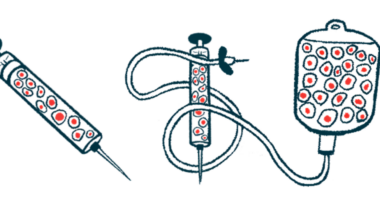Longer rituximab treatment intervals don’t affect safety, efficacy
Risk of side effects may be reduced with longer period between infusions

People with multiple sclerosis (MS) may receive less frequent infusions of rituximab without increasing their chances of relapse or disease progression, according to a real-world study from Norway.
After receiving three doses at six-month intervals, extending the time between following doses to nine months is “a safe and effective treatment option for MS patients,” the researchers wrote. Waiting longer between infusions may also reduce the risk of infection for people treated with rituximab.
The study, “Early extended interval dosing of rituximab in multiple sclerosis: A comparative cohort study on efficacy and safety,” was published in Multiple Sclerosis and Related Disorders.
Rituximab, used to treat certain cancers, has been used off label for MS. The therapy targets immune B-cells, which drive the inflammatory response in the disease.
The treatment may also affect the immune system more broadly, leading to low antibody levels (a condition called hypogammaglobulinemia, or hypo-IgG), reduced white blood cell counts (neutropenia), and increased vulnerability to infection. Neutropenia and hypo-IgG can cause flu-like symptoms and further increase risk of infection.
Rituximab treatment options
Rituximab is typically delivered to MS patients via infusion into the bloodstream every six months. A hospital in Norway, as part of its response to the COVID-19 pandemic, offered patients the option of waiting nine months between infusions after they received the first three doses.
In the study, researchers compared the outcomes for people with MS on this extended interval dosing plan (78 patients) to outcomes for a similar group at another Norwegian hospital that continued to deliver treatment at the standard six-month intervals (217 patients). More than 95% of patients in both groups had relapsing-remitting MS.
Patients at the two hospitals were “from the same health care system followed during the same time period [and had] similar baseline characteristics,” the researchers noted. According to the team, this allowed for a more robust control group than previous investigations, which had more variability.
Results showed that there was no significant difference in MS relapse rates between the group receiving the extended-interval dosing and those on the standard interval.
Over a median follow-up period of 15-18 months, no relapses were reported in the nine-month treatment interval group, and two relapses were reported in the group receiving treatment every six months. Because relapses were relatively infrequent, this rate had no statistical significant difference between the two groups analyzed.
Researchers also looked at the occurrence of new MRI lesions, a sign of damage in the myelin sheath, a fatty substance that protects nerve cells and is attacked by the immune system in MS. MRIs were performed on about 75% of the patients.
Data showed that the number of new lesions was similar in both groups. Compared with baseline scans taken earlier in treatment, 2%-3% of MRIs at each hospital showed new areas of myelin loss.
An analysis revealed that patients with a nine-month treatment interval had an estimated 82% lower risk of experiencing negative rituximab side effects — including infection, neutropenia, and hypo-IgG — during the follow-up period. But when excluding moderate infections from the analysis, this result was no longer significant.
This indicates that the lower risk of experiencing side effects was primarily a result of fewer moderately severe infections requiring antiviral or antibiotic treatment in the extended interval group. In the end, the two groups did not have a significantly different risk of developing neutropenia, hypo-IgG, or severe infections requiring hospitalization.
Overall, the results support prior findings indicating that rituximab treatment maintains its efficacy at extended-interval dosing, and suggests that lower treatment frequency may reduce the risk for some side effects of the medication.
The findings “suggest that initiating early 9-month [extended interval dosing] in stable [MS patients] after two 6-month dosing intervals is an effective and safe treatment strategy,” the researchers wrote.
Future studies will help researchers better understand any long-term effects of increasing the treatment interval with rituximab, the team concluded.







